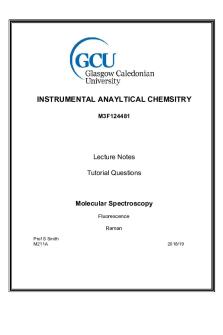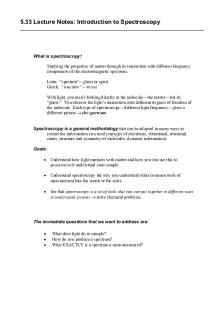Week 12 (Raman spectroscopy) Lecture Notes PDF

| Title | Week 12 (Raman spectroscopy) Lecture Notes |
|---|---|
| Course | Spectroscopy And Analytical Chemistry |
| Institution | Monash University |
| Pages | 41 |
| File Size | 2.3 MB |
| File Type | |
| Total Downloads | 85 |
| Total Views | 158 |
Summary
Monash University CHM2922: Molecular Spectroscopy Lecture Notes (Week 9 to 12) by Dr. Toby Bell...
Description
CHM2922 – Raman spectroscopy
2021
Objectives
1. Discuss the theory of Raman spectroscopy 2. Distinguish between Rayleigh scattering and Raman scattering 3. Investigate the importance of lasers, array detectors & FT techniques for Raman spectroscopy 4. Understand what is meant by polarisability of a molecule
5. Explore instrument components in Raman spectrometers 6. Look at Resonance Raman spectroscopy
What is Raman Spectroscopy?
P.of.I.A 18A
• Raman spectroscopy is a kind of vibrational spectroscopy. • That is, it yields information about the vibrational levels of a molecule. • Raman spectroscopy is often referred to as a complementary technique to infrared spectroscopy.
• BUT! … it uses visible or near IR light.
Δcm-1 or cm-1
What is Raman Spectroscopy?
P.of.I.A 18A
• Raman spectra are typically acquired by irradiating the sample with a visible or near-infrared laser source.
• The sample may either absorb, transmit or scatter the radiation - often all three processes occur.
• The scattered radiation may be measured at some angle (often 90o)
What is Raman Spectroscopy?
P.of.I.A 18A
• C.V. Raman - Nobel Prize in Physics 1930 • Observed that when visible light was scattered by certain molecules, a small amount had either higher or lower, yet discrete wavelengths.
➢ A quantum effect! • This “Raman” scattering is a only a weak phenomenon, and it has taken until the last few decades with the advent of lasers, array detectors and cheaper modern instruments before it has come into regular analytical use.
What is Raman Spectroscopy?
P.of.I.A 18A
Key concept: We are irradiating the sample with visible (or near IR) radiation. How can this give us information about fundamental vibrations? Energies of these correspond to photons from the mid-IR!
Differences in energies of incident and scattered photons contain information about vibrational energy levels
What is Raman Spectroscopy?
P.of.I.A 18A
• Most photons are scattered elastically and their energy (i.e. frequency/wavelength) is unchanged. • This is called “Rayleigh” scattering.
Rayleigh
• Stokes and anti-Stokes scattering occur when the interaction is inelastic and a quantum of vibrational energy is lost or gained by the scattered photon • The molecule also gains or loses a quantum ensuring momentum is conserved.
Stokes & Anti-Stokes Scattering
P.of.I.A 18A
• One way to think about scattering is by invoking a “virtual state”.
• The molecule is excited very briefly to a virtual state before spontaneously scattering a photon.
• Inelastic scattering provides the useful information, however only as little as 1 in a 1,000,000 photons are Stokes or anti-Stokes Raman scattered. Very Weak!
The Role of Lasers
P.of.I.A 18A
• Solution? Use lots of photons! • Until the development of lasers, Raman spectroscopy was not generally used for analytical applications, however the photon densities provided by lasers allow a more detectable yield of Raman scattered photons.
Lasers – CHM3952!!!!
So how did Raman do the experiment?
Key point in Raman Spectroscopy Rayleigh
P.of.I.A 18A
• Raman spectrum plots the difference between rayleigh (excitation) and raman scatter • Difference is caused by loss (or gain) of a quantum of vibrational energy
ν or Δν / cm-1
Intensity of Normal Raman Bands.
P.of.I.A 18A-4
• In infrared spectroscopy, we saw that the intensity of a band was proportional to the square of the transition dipole moment. • Band intensities in Raman are dictated by a complex interaction of factors including the polarisability of the molecule, the intensity of excitation source, the frequency of the excitation source and the concentration of the sample. • Polarisability is the ratio between the induced dipole moment by an electric field, E (in this case from the electromagnetic radiation) and the electric field.
=
E
Polarisability of CO2 vibrational modes
Intensity of Normal Raman Bands. • This distinction between IR and Raman intensities can produce markedly different spectra
• Strong bands in the IR are often weak in Raman and vice versa.
P.of.I.A 18A-4
Can do dispersive and FT Raman • Dispersive instruments simultaneously measure all wavelengths by separating them onto a 2D element such as a CCD detector.
grating
CCD detector Raman source
P.of.I.A 18B-3
• FT instruments simultaneously measure all wavelengths via a Michelson interferometer.
FT Raman Spectrometers
P.of.I.A 18B-3
Gases, Liquids & Solids • Gases may be analysed by passing the excitation source directly through a gas cell. • External mirrors allow multiple passes to maximise Raman scattering.
P.of.I.A 18B-2
Gases, Liquids & Solids • Liquids can be illuminated directly onto (b) capillaries, (c) cylindrical cells, or small ampoules. • Via capillaries volumes as small as a nanolitre may be measured. • Unlike in the infrared, glass sample holders can be used since visible and near-IR radiation is transmitted • Sample handling is significantly less complicated!
P.of.I.A 18B-2
Gases, Liquids & Solids • Solids may be measured as (d) pellets (bottom right) or even ‘as-is’ without additional preparation.
• Since near-IR transmits efficiently via optic fibre, instruments are often able to utilise several metres of emission fibre into the monochromator.
P.of.I.A 18B-2
Resonance Raman Spectroscopy • In RRS the incident photons are deliberately tuned to an electronic transition of the molecule
P.of.I.A 18D-1
S1
• Notice how this transition mechanism is different to fluorescence. • In RRS emission occurs directly from the excitation level. • Intensity increase can be orders of magnitude in the right conditions!
S0 10-14 s
10-10-10-6 s
Warning This material has been reproduced and communicated to you by or on behalf of Monash University in accordance with s113P of the Copyright Act 1968 (the Act). The material in this communication may be subject to copyright under the Act. Any further reproduction or communication of this material by you may be the subject of copyright protection under the Act. Do not remove this notice.
CHM2922 – Gas analysis
2021
Objectives
1. Examine how detection of gases by vibrational and UV-vis spectroscopy can be achieved 2. Examine some applications of various spectroscopic techniques in gas analysis 3. Justify choice of instrumental method(s) to monitor gases in exhaust plumes, workplace environments and in the atmosphere
Atmospheric CO2 • CO2 is present at 100s of ppm level: It just reached 410 ppm (Up from ~280 ppm in mid 19th Century) • Careful and accurate measurement is vital!
Methane is 23 times more potent than CO2; N2O is 310 times more potent! https://www.co2.earth/
Gas Analysis
P.of.I.A 17A
• Atmospheric monitoring • Remote Sensing - performing measurements on the environment at a distance • Sampling
• Measurements can be made using emission or absorption detect photons emitted by excited molecules
detect reduction in incident photons caused by absorption
M*
M*
M
M
IR Gas Analysis - Absorption • Sample collection for lab analysis • Collection from site or via plane, balloon etc… • Spectrum of gas is obtained at leisure
P.of.I.A 17A
long path cells - in lab or on site
IR Gas Analysis - Absorption
P.of.I.A 17A
“ALIAS” has flown over 300 times in 7 major NASA missions!
• High resolution, 4-channel scanning tunable laser spectrometer (3.4 to 8 µm) • Direct, simultaneous measurements of HCl, NO2, CH4, N2O, and CO in the strato- and troposphere at sub-ppb! • 80-m pathlength in a 1-m multipass Herriott cell • ‘Spatially resolved’ atmospheric data!
IR Gas Analysis - Absorption
P.of.I.A 17A
• Solar Occultation: • Uses the sun as UV-vis & IR source for absorption spectrum
• Ground base - long path, long observation time, pressure broadening, water E.g. The Wollongong centre for atmospheric chemistry monitors for: O3, ClONO2, HNO3, HCl, CFC-11, CFC-12, CFC-22, NO2, N2O, NO, HF, C2H2, C2H4, C2H6, CH4, CO, COF2, H2O, HCN, HO2, NO2, NH3, N2, OCS. https://www.uow.edu.au/science-medicinehealth/research/centre-for-atmospheric-chemistry/
IR Gas Analysis - Absorption
P.of.I.A 17A
• Solar Occultation: • From a plane or a balloon – or a space shuttle!
• VERY long path lengths – high sensitivity
Space shuttle 200 km profile in a 30 sec sunrise/sunset! - requires very fast spectrometer (0.01 cm-1 spectra in...
Similar Free PDFs

Raman Spectroscopy
- 22 Pages

Spectroscopy Lecture Notes
- 52 Pages

12 - Lecture notes 12
- 3 Pages

Week 12 Finance 1 Lecture Notes
- 10 Pages

BI513 - Lecture notes week 1-12
- 146 Pages

FINC201 Week 1-12 Lecture Notes
- 36 Pages

Lecture notes, lecture 12
- 9 Pages

Lecture notes, lecture 12
- 7 Pages

Week 12 Notes
- 2 Pages

Week 12 Corporations Notes
- 7 Pages

Spectroscopy
- 5 Pages

Chapter 12 - Lecture notes 12
- 4 Pages

Lab 12 - Lecture notes 12
- 5 Pages
Popular Institutions
- Tinajero National High School - Annex
- Politeknik Caltex Riau
- Yokohama City University
- SGT University
- University of Al-Qadisiyah
- Divine Word College of Vigan
- Techniek College Rotterdam
- Universidade de Santiago
- Universiti Teknologi MARA Cawangan Johor Kampus Pasir Gudang
- Poltekkes Kemenkes Yogyakarta
- Baguio City National High School
- Colegio san marcos
- preparatoria uno
- Centro de Bachillerato Tecnológico Industrial y de Servicios No. 107
- Dalian Maritime University
- Quang Trung Secondary School
- Colegio Tecnológico en Informática
- Corporación Regional de Educación Superior
- Grupo CEDVA
- Dar Al Uloom University
- Centro de Estudios Preuniversitarios de la Universidad Nacional de Ingeniería
- 上智大学
- Aakash International School, Nuna Majara
- San Felipe Neri Catholic School
- Kang Chiao International School - New Taipei City
- Misamis Occidental National High School
- Institución Educativa Escuela Normal Juan Ladrilleros
- Kolehiyo ng Pantukan
- Batanes State College
- Instituto Continental
- Sekolah Menengah Kejuruan Kesehatan Kaltara (Tarakan)
- Colegio de La Inmaculada Concepcion - Cebu


